Alternative fuels, new jets highlight bizav event in Geneva
21 aircraft fly to EBACE using renewable fuel
The General Aviation Manufacturers Association (GAMA) said that 21 aircraft using alternative fuels arrived at Geneva International Airport in Switzerland for the May 21 to 23 European Business Aviation Convention and Exhibition (EBACE).
GAMA reaffirmed that a worldwide coalition of business aviation organizations supports the sustainable alternative jet fuel initiative. The association said that the movement has “gained global momentum” toward a journey to a “lower carbon future” since the initiative began in 2018.
The group pointed out that sustainable and renewable jet fuel products were made available at several airports in the United States, England, France, and Sweden to allow jets to fuel up on the lower-emission option for the EBACE journey.
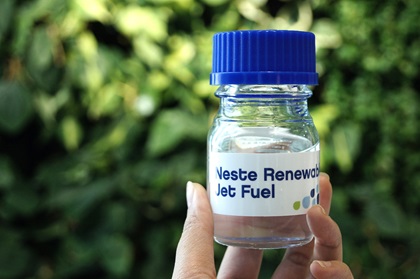
Air BP made sustainable aviation fuel available to general and business aviation customers and aircraft manufacturers at two European airports. Stateside, Republic Airport in Farmingdale, New York, also offered the alternative jet fuel at the Sheltair fixed-base operation.
Sweden’s Stockholm Arlanda airport and France’s Caen Carpiquet airport were pumping fuel produced by Neste, a renewable fuels producer. The company said that the renewable jet fuel alternative uses “sustainable raw materials” and can “produce up to 80 percent fewer emissions over its life-cycle compared with conventional jet fuel.”
Proponents pointed out that the fuel is safe and doesn’t impact aircraft performance, offers benefits to airports and surrounding communities, and reflects business aviation’s commitment to reduce the carbon footprint.
However, one hindrance that has yet to be overcome is the price premium for switching to sustainable fuels, which may cost three times (or more) per gallon than conventional jet fuel.
Despite the price premium, a 2018 study by the Missouri University of Science and Technology pointed to several benefits of the renewable fuel technology. The analysis concluded that when alternative fuel products were blended with conventional fuel they would “significantly reduce sulfur dioxide” and other particulates, “generally reduce carbon monoxide and unburnt hydrocarbon emissions,” and “minimally reduce or have no effect on nitrogen oxide emissions.”
Members of the business aviation community’s commitment to climate change pledged a two-percent improvement in fuel efficiency from 2010 through 2020, “carbon-neutral growth” from 2020 onward, and “a 50 percent reduction in carbon emissions by 2050,” based on 2005 numbers, GAMA said.
The alternative fuel can be produced from renewable resources including feedstocks, crop residues, woody plants, purpose-grown grass, and other agricultural crops.
Embraer Praetor 600 FAA and EASA certified
Embraer‘s new Praetor 600 super-midsize business jet was granted type certificates by the FAA and the European Union Aviation Safety Agency (EASA) during EBACE on May 20. Brazil’s Civil Aviation Authority awarded the aircraft a type certificate in April.
The Praetor 600 and its midsize model 500 sister ship debuted during the 2018 National Business Aviation Association Convention and Exhibition in October. Embraer Executive Jets President and CEO Michael Amalfitano lavished the fly-by-wire Praetor 600 with superlatives, calling it “the most disruptive and technologically advanced super-midsize business jet” in its segment.

The company said the 600 was “the best performing super-midsize jet ever developed” and surpassed all of its design goals. The flat-floor cabin aircraft has a four-passenger range of 4,018 nautical miles with reserves at long range cruise and is touted as the “farthest flying super-midsize jet.” It can fly 3,719 nautical miles at Mach 0.80 with four passengers and full fuel, and at altitudes up to 45,000 feet.
The jet is capable of nonstop flights between London and New York, São Paulo and Miami, or Dubai and London, and is configured with eight fully reclining seats that can double as four beds (which might be needed for such a journey.)
Rockwell Collins Pro Line Fusion avionics suites and turbulence-reduction technology are standard, and other enhanced systems are available. Deliveries of the model 600 are expected to begin “in the second quarter” of 2019 and the model 500 is expected to follow in the third quarter.
Gulfstream G550 sets record using alternative fuel
A Gulfstream G550 set an unofficial city-pair speed record powered by sustainable alternative jet fuel en route to EBACE on May 17. The journey connected Charleston, South Carolina, with Farnborough, England, a distance of 3,591 nm at an average speed of Mach 0.85 in 7 hours and 13 minutes, the aerospace manufacturer said.
Gulfstream and other business jet manufacturers are promoting the development and adoption of sustainable alternative jet fuel, which Gulfstream President Mark Burns said was “safe, approved, does not hinder aircraft performance and provides a long-term benefit to the environment.”
The company said it would start using the alternative fuel to “power large-cabin completion flights” departing from California’s Long Beach Airport and also begin regular sales of sustainable alternative jet fuel to airport customers. California-based World Energy refines the sustainable jet fuel provided by World Fuel Services at a refinery close to the airport.
Gulfstream G600 achieves testing milestone
Gulfstream announced that its G600 ultralong-range jet was in the “final stage” of function and reliability flying required for the aircraft’s FAA type certification. The jet was designed with customer input and boasts an expected 6,500-nm cruise at Mach 0.85. When traveling at Mach 0.90 the G600 could make short work of a Geneva-to-Hong Kong flight and takes its place in the lineup with its 18-passenger G500 sister ship.
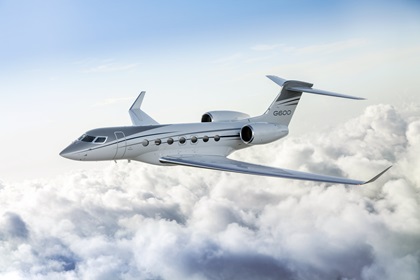
The jet has 14 windows; high-speed internet; satellite communications; and configurations that can accommodate up to four flexible areas for work, entertainment, dining, and rest.
In addition to the clean-sheet G600, the Savannah, Georgia, manufacturer brought a fleet of contenders to the EBACE static display ramp, including the company’s flagship G650ER, the high-performing G550, the super-midsize G280, and the new G500.
HondaJet's headquarters to expand
Honda Aircraft Co. announced plans to expand its Greensboro, North Carolina, global headquarters in July. The manufacturer will invest an additional $15.5 million in a new 82,000-square-foot HondaJet manufacturing facility on its 133-plus acre campus. The recently introduced five passenger/two crew HondaJet Elite is outfitted with Garmin G3000 avionics, and boasts a maximum cruise speed of 422 knots, a maximum altitude of 43,000 feet, and a range of 1,437 nm.
Piper Aircraft displays M-class, trainer aircraft
Piper Aircraft said its static display included M-class aircraft and popular trainers. The Vero Beach, Florida, company touted the flagship Piper M600’s “continent crossing range and impressive payload capability” as an “ideal stable-mate” for corporate flight departments. The Pratt and Whitney PT6A-42A 600-shaft horsepower engine allows the six-seat aircraft to have a maximum cruise speed of 274 knots, a range of 1,658 nm, and a useful load of 2,400 pounds.
Textron Aviation displays Citation Latitude air ambulance
Textron Aviation showcased its first air ambulance configuration of the Citation Latitude. The aircraft was purchased by Babcock Scandinavian Air Ambulance for aeromedical operations in Norway and can be outfitted with a wide range of medical equipment.
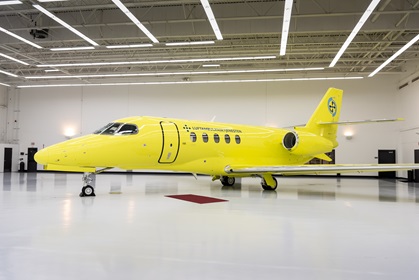
The flat-floor Citation Latitude has a four-passenger range of 2,700 nm at high-speed cruise and a takeoff field length of 3,580 feet. The manufacturer said the aircraft’s capability can help provide operators with “greater range out of short fields” and “an unrivaled cabin experience.”
Textron’s plans for its static display also included a Citation Longitude super-midsize jet, a Grand Caravan EX, a Citation XLS+ light midsize business jet, a Citation CJ3+ light jet, a Citation M2 entry-level jet, a Beechcraft King Air 350i turboprop, and two helicopters—a Bell 505 and a Bell 429.
Cessna SkyCourier prototype assembly underway
Textron Aviation announced several milestones in its “clean-sheet design” Cessna SkyCourier twin utility turboprop that is designed to handle three standard air cargo containers with a payload up to 6,000 pounds—or up to 19 passengers—depending on configuration.
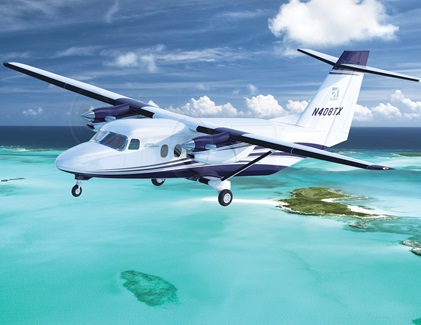
Assembly is underway for the prototype aircraft and five additional flight and ground test articles. Component testing for the new McCauley 110-inch propeller, nose landing gear, and fuel system are underway with testing to begin “later this month.” The aircraft will be powered by the Pratt and Whitney Canada PWC PT6A-65B 1,100-shp engine.
FedEx Express signed on in late 2017 as the launch customer for up to 100 aircraft, with an initial fleet order of 50 cargo aircraft and options for 50 more.
Cessna Denali prototype taking shape
The eight- to 11-occupant single-engine turboprop Cessna Denali prototype is “nearing completion” along with the first two flight and three ground test articles, Textron Aviation said.
The company also recently completed component integration for the Denali “iron bird, a full systems simulator test rig laid out in the configuration and size of the Denali,” the company noted. The powerplant will be a GE-driven 1,300 shp Catalyst engine and a “state-of-the-art” 105-inch McCauley composite propeller.
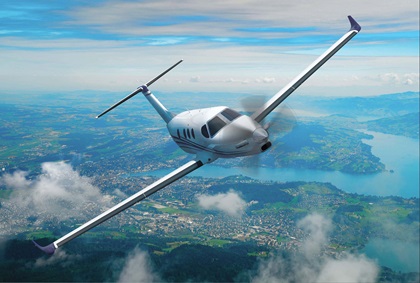
Chris Hearne, Textron Aviation senior vice president of engineering, said the aircraft was “designed and built to outperform the competition in capability, pilot interface, cabin experience and total ownership costs.” He also pointed out that the powerplant would bring reduced ownership costs by “meeting or exceeding performance expectations” by deploying new technology that “allows for a much longer time between overhaul, quieter operation.” He added that the “first-ever digital engine and propeller control” would reduce pilot workload and “have greater fuel efficiency than similar aircraft in its class.”
Textron European parts warehouse expands
In other news, Textron Aviation said it plans to double its Düsseldorf, Germany-based European distribution center in 2019 to include “nearly 35,000 items” that will help to service Beechcraft, Cessna, and Hawker aircraft. The company said it leads the European market with more than 1,800 jet and turboprop aircraft operating in the region and intends to continue providing “unrivaled support” for aircraft operating worldwide.



